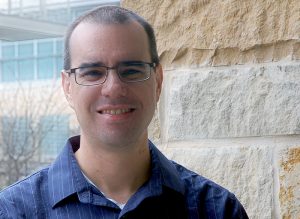 Tim Danner, MCS alumnus and Director of Architecture at SolarWinds, appreciates the elegance of simplicity. “The easy part about software is to write more code,” he said. “But what is most satisfying for me is to find new ways to solve problems with existing components combined in new ways. Even better is when you can eliminate a component without losing functionality. Code is both an asset and a liability.”
Tim Danner, MCS alumnus and Director of Architecture at SolarWinds, appreciates the elegance of simplicity. “The easy part about software is to write more code,” he said. “But what is most satisfying for me is to find new ways to solve problems with existing components combined in new ways. Even better is when you can eliminate a component without losing functionality. Code is both an asset and a liability.”
Danner was fascinated by personal computers and computer performance in high school. He said, “I was building PCs, replacing parts, and generally tinkering. I wanted to understand at a low level what was going on and how these dramatic year-by-year improvements in performance were possible.”
He was interested in computer engineering and looked at universities everywhere but Houston. “I grew up here, so when it came time to look at colleges, my first goal was to go somewhere far away,” said Danner. “But my uncle, a Rice alum, wrote me a very thoughtful letter about the ways in which Rice was a better choice. That, plus a tour and a meeting with his old roommate (Computer Science professor Keith Cooper), convinced me that Rice’s undergraduate focus and culture made it the right choice for me.”
After majoring in electrical engineering, Danner said his curiosity about why computers changed so rapidly was satisfied. “Once I had learned the low level pieces like physical electronics, digital logic, and VLSI, then I could move up the stack into computer architecture, compilers, and core algorithms. It was at this point that I realized the leverage that comes from working at a higher level. You can solve bigger problems faster by building on top of those tools.”
So he began the professional masters in computer science (MCS) program and took a wide variety of classes on broad topics. He said, “I remember being in Dr. Subramanian’s AI course and learning how to restructure a fuzzy problem so you can bring algorithms to bear. And Dr. Wallach’s security course taught me how to think about systems – and not just computer systems – in an adversarial way.”
As Danner wrapped up his MCS degree, he accepted an offer from a startup in the software industry. “But they called right before graduation and asked if they could delay my start date by six months. I said, ‘no thank you’ and looked for something a little more stable,” Danner said.
His first job was at Mission Critical Software, where he shared an office with another developer, Lee McClendon. They remained friends even as their paths diverged. Several years later, McClendon reached out to Danner and told him, “You need to think about coming to SolarWinds. This company is really going places.”
 SolarWinds helps companies solve some of their IT problems with solutions that are easily downloaded from a website and inexpensive enough to be purchased with a credit card. Danner said, “Previously your network management options were usually big and costly, and required a team of consultants to help implement and manage them. Our model solves the same kinds of problems, but more simply and more affordably.”
SolarWinds helps companies solve some of their IT problems with solutions that are easily downloaded from a website and inexpensive enough to be purchased with a credit card. Danner said, “Previously your network management options were usually big and costly, and required a team of consultants to help implement and manage them. Our model solves the same kinds of problems, but more simply and more affordably.”
He described one of their most popular new software developments, a product called NetPath. “It analyzes the network path from your user to the source. When there is a problem with the connection, it identifies exactly which part of the chain is causing the problem.”
Since Danner joined the company as a technical lead, it has grown from 80 to about 2500 employees, and Danner’s management perspective has scaled up as well. He said he had to make a mental shift in order to be successful as a manager in such a rapidly evolving company. “The most important thing is not the project, it is the people: keeping them engaged, satisfied, and growing has to take priority over any particular task.”
Tim Danner completed his Masters of Computer Science (M.C.S.) in 2001.
